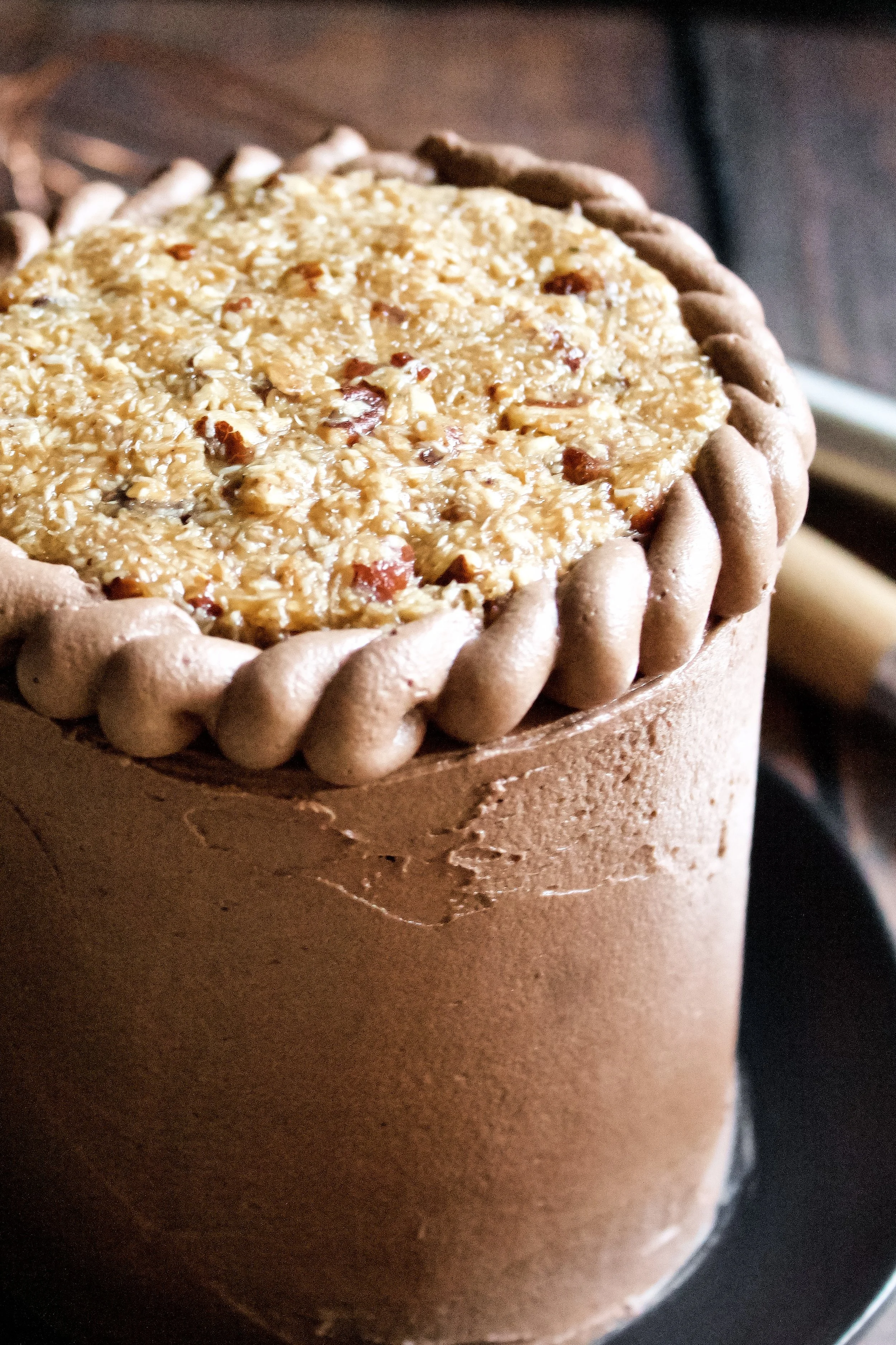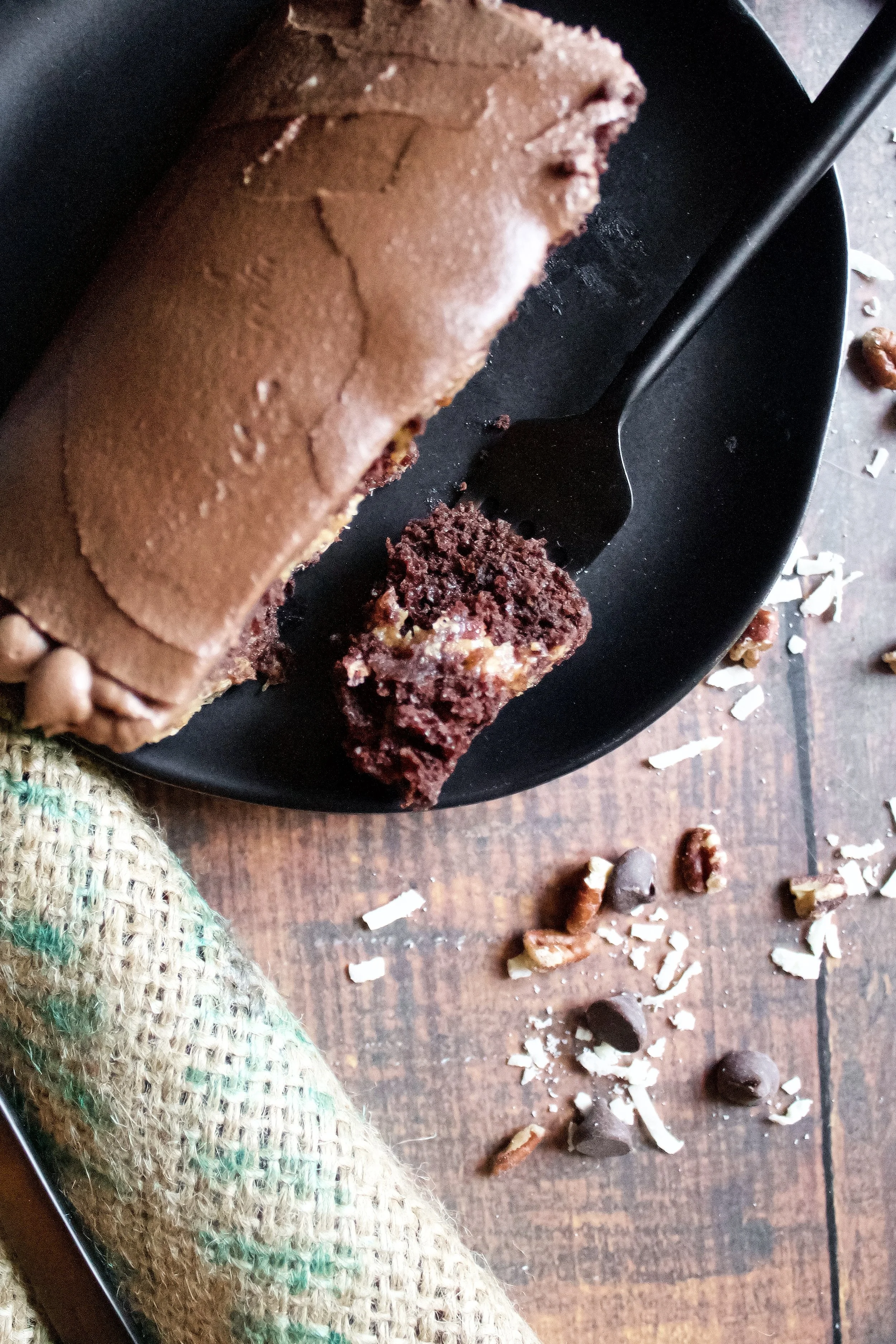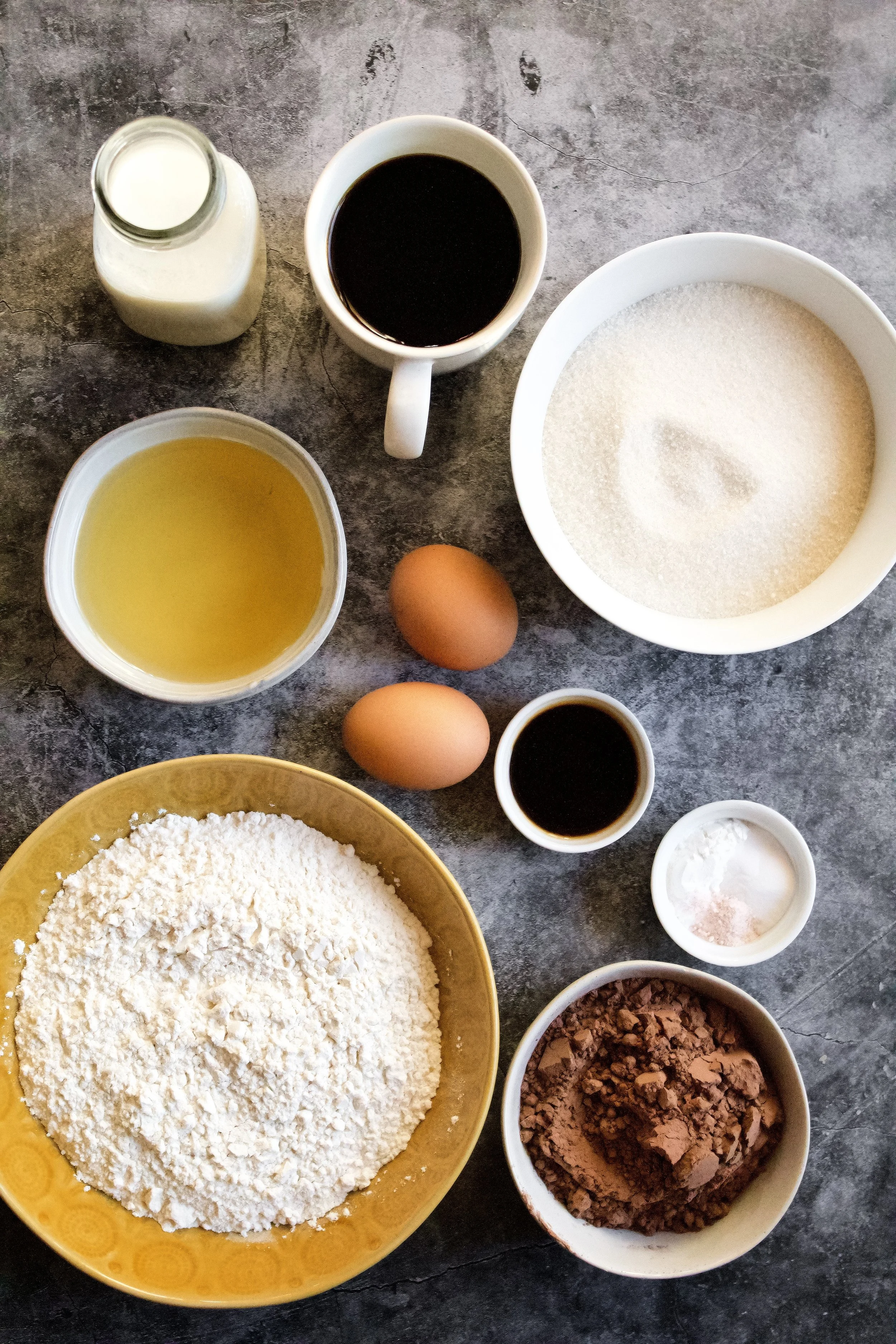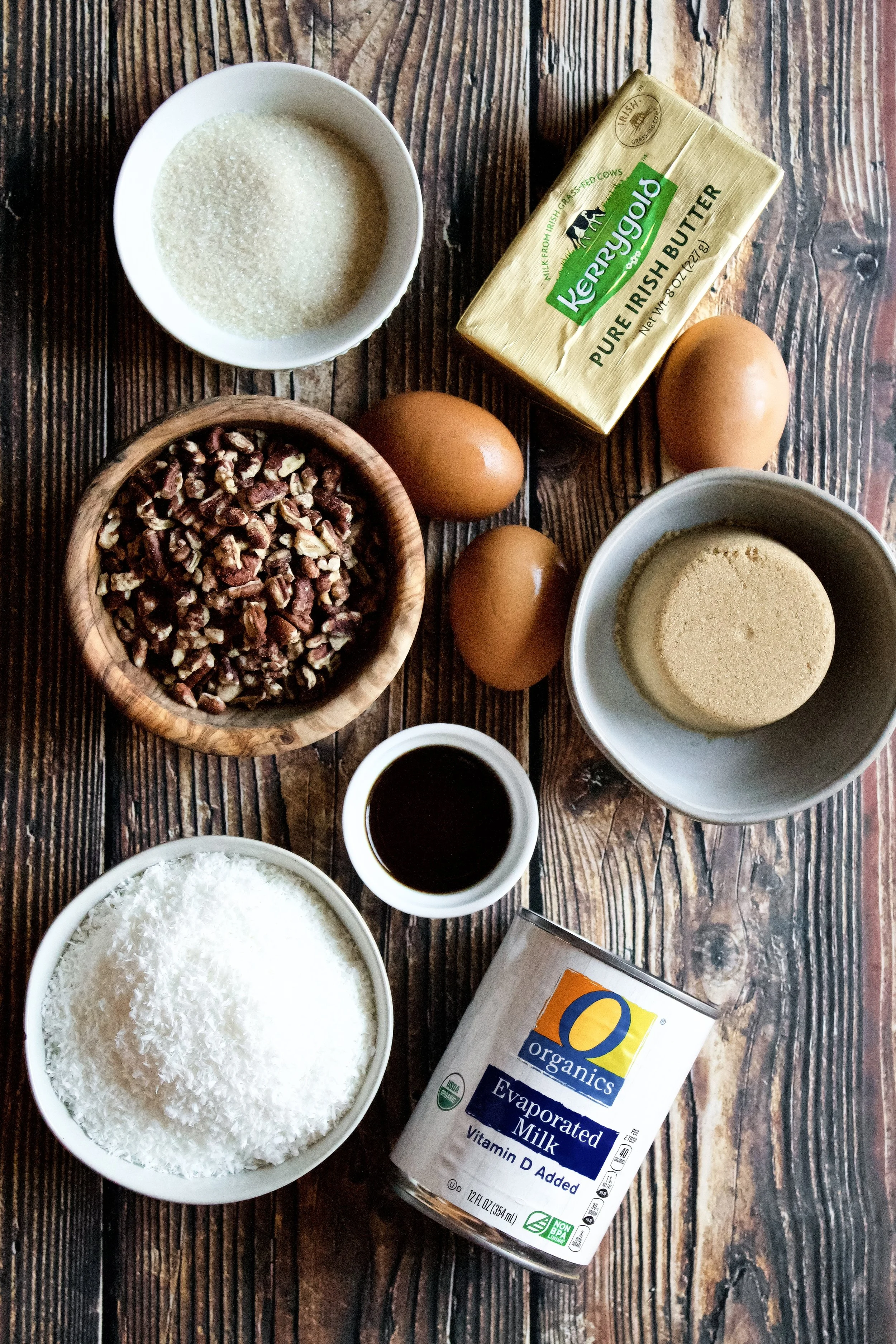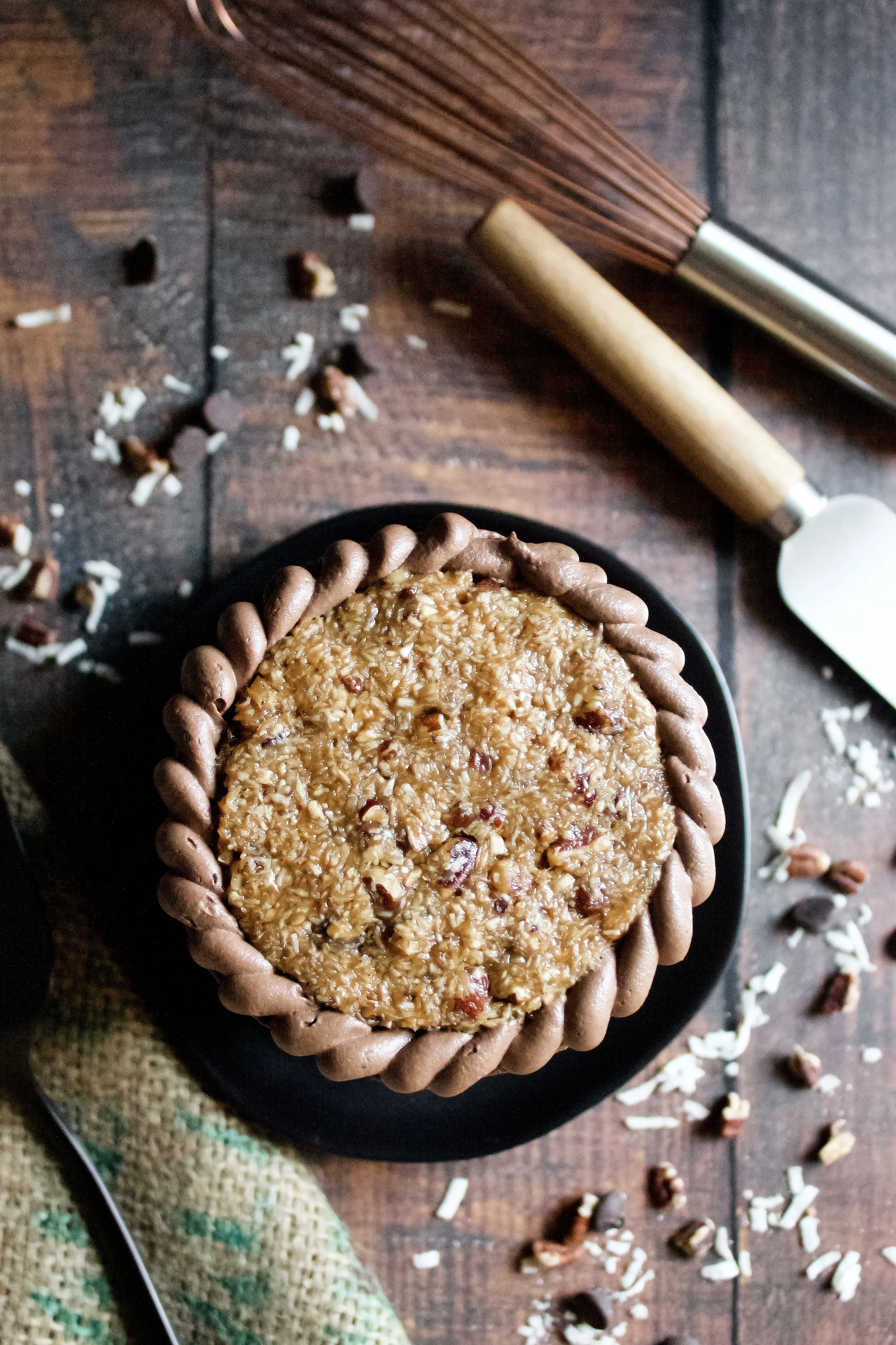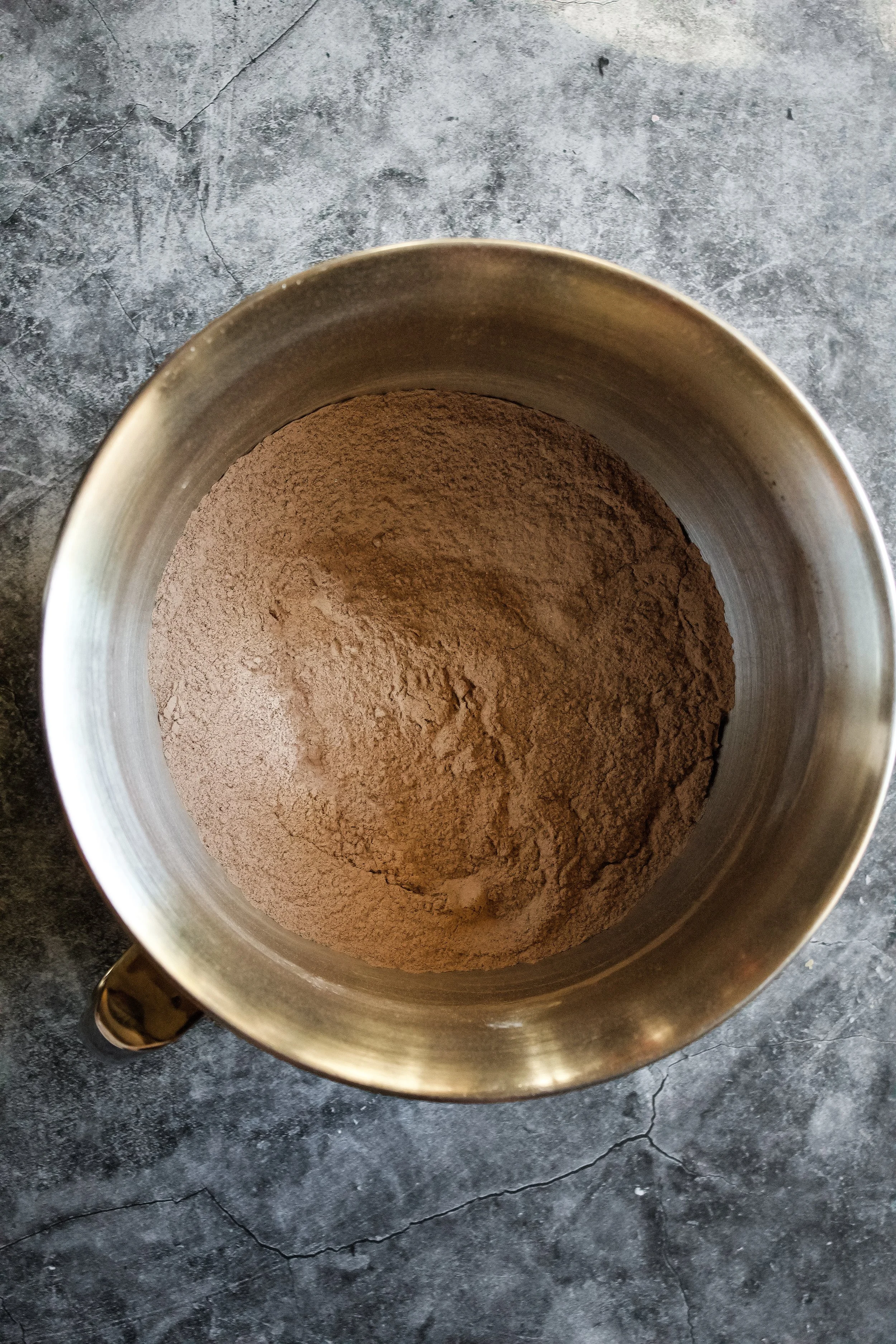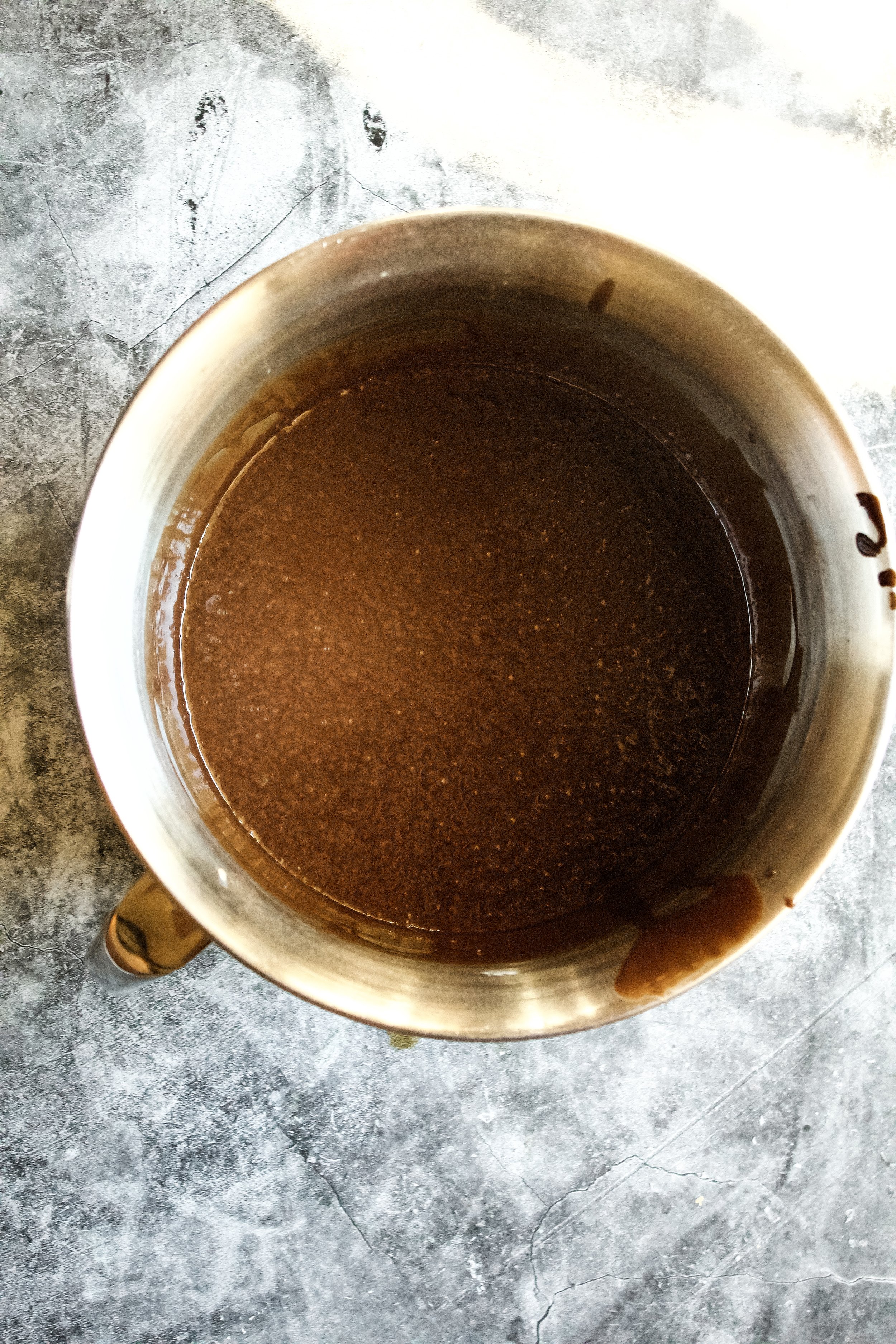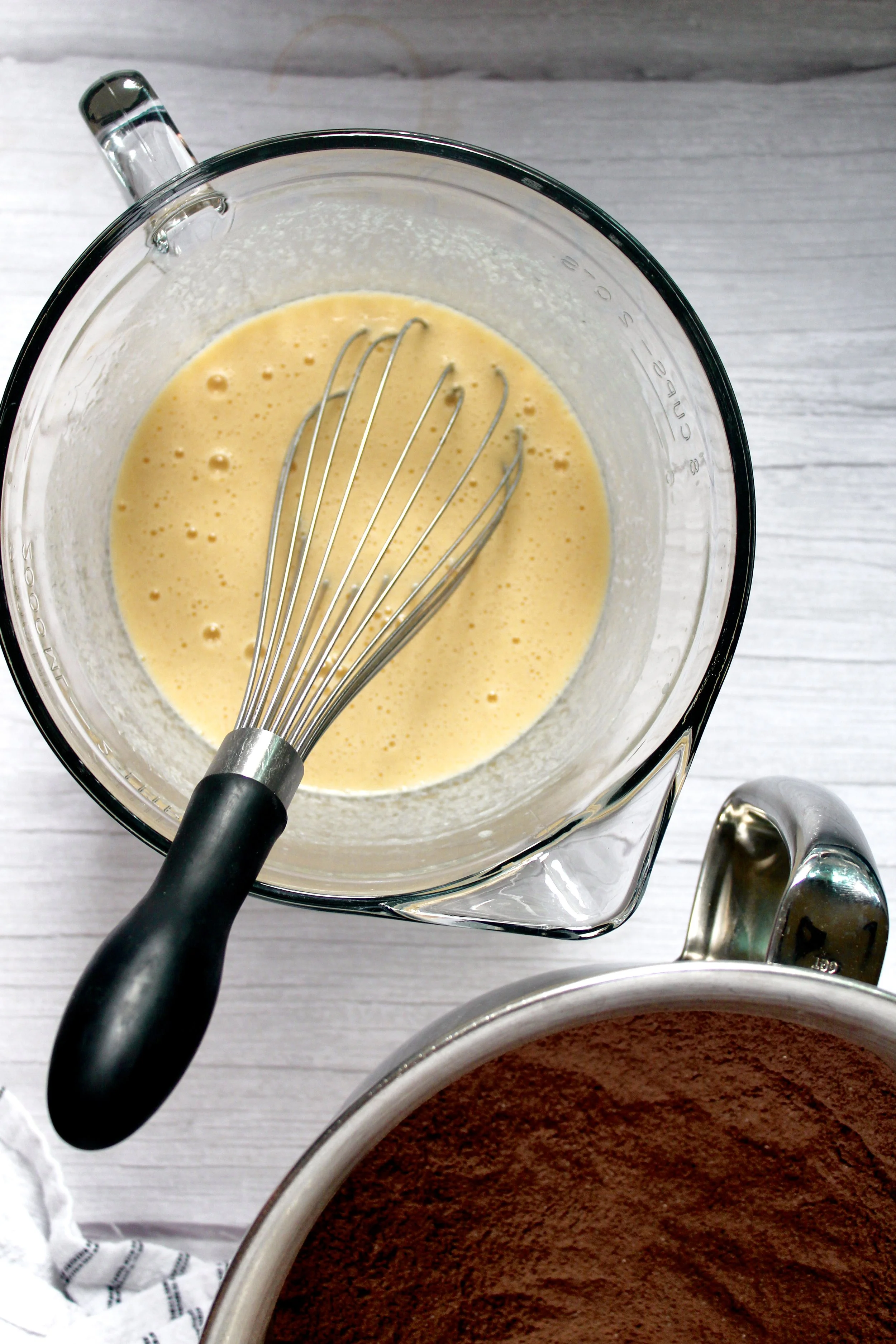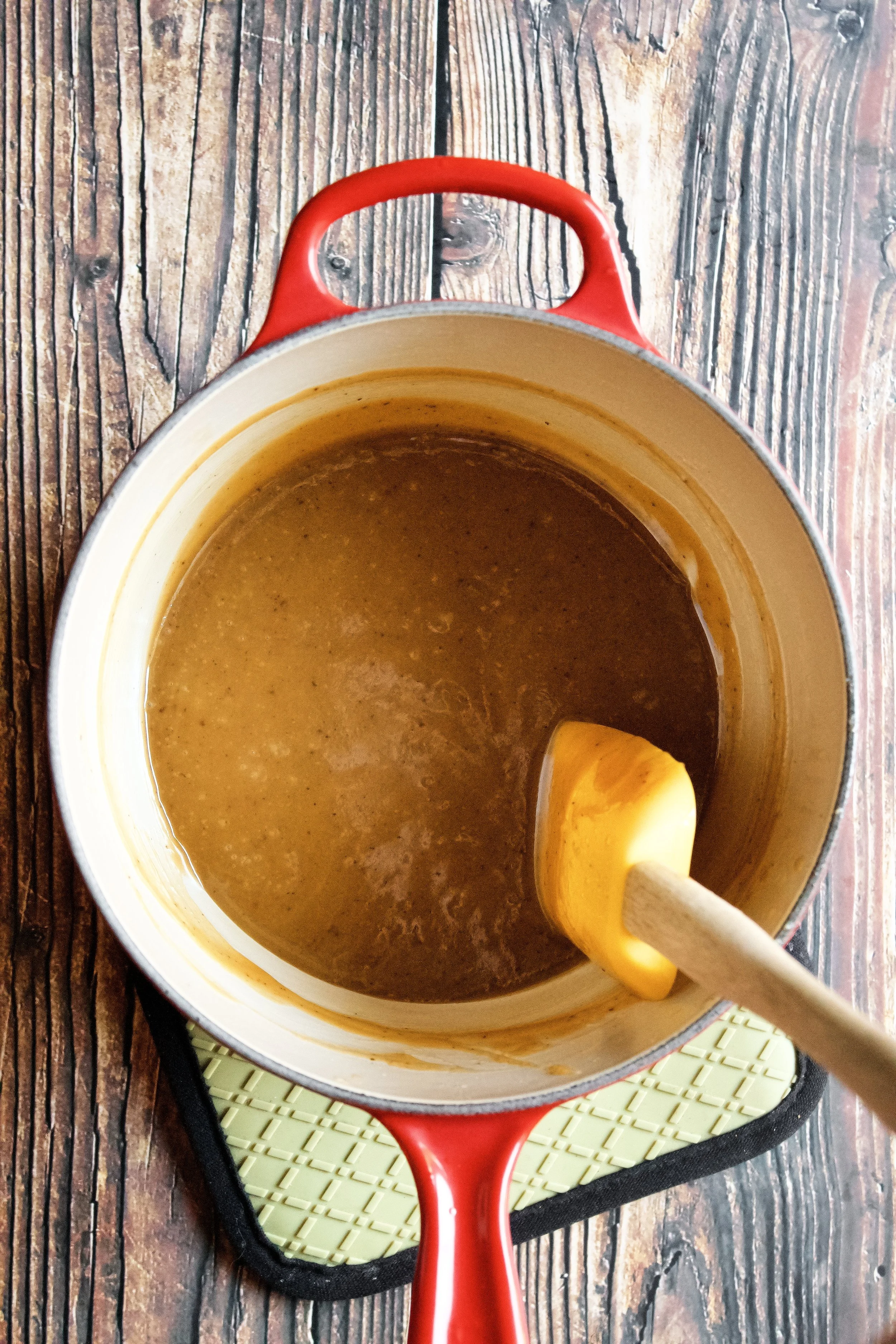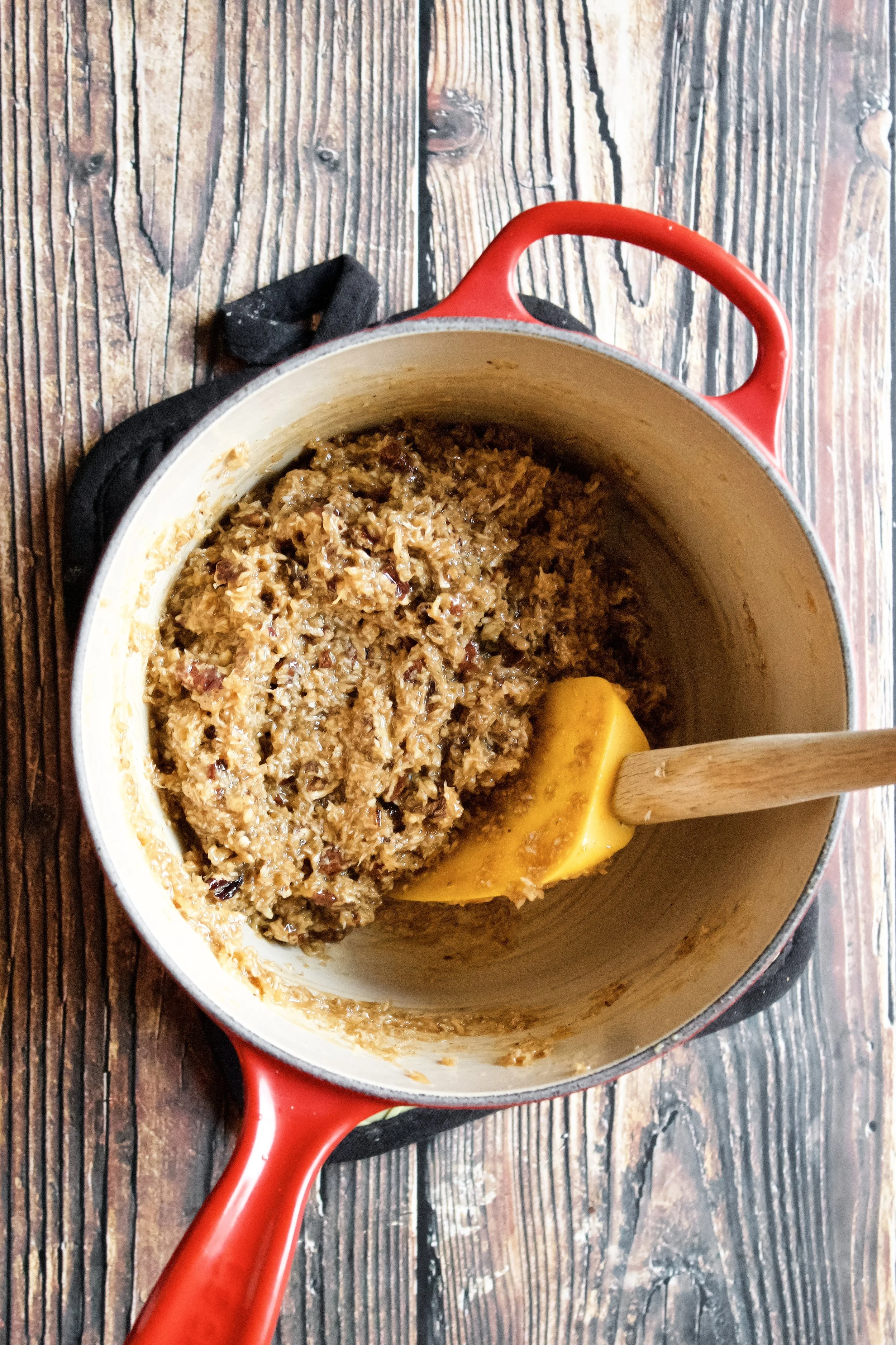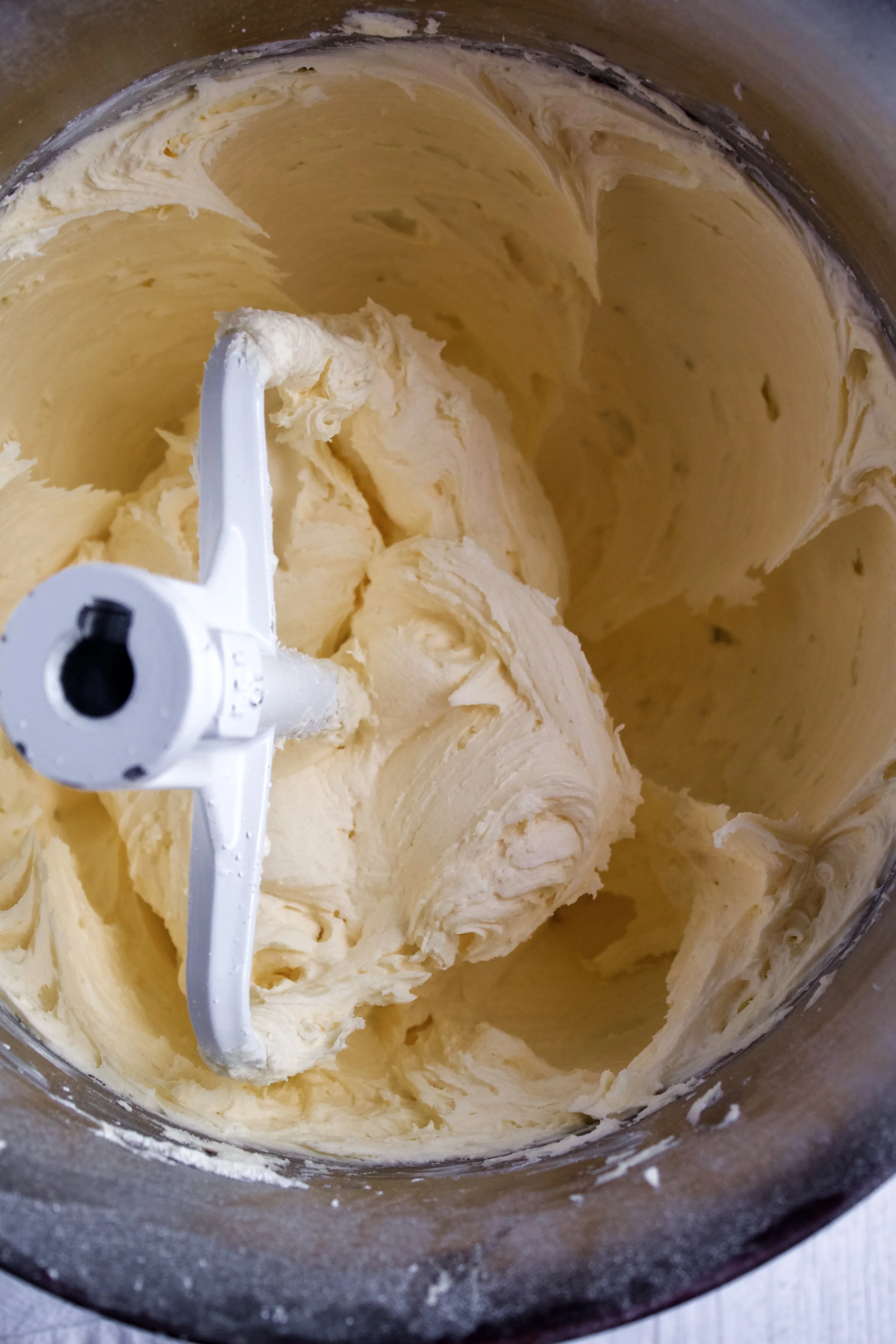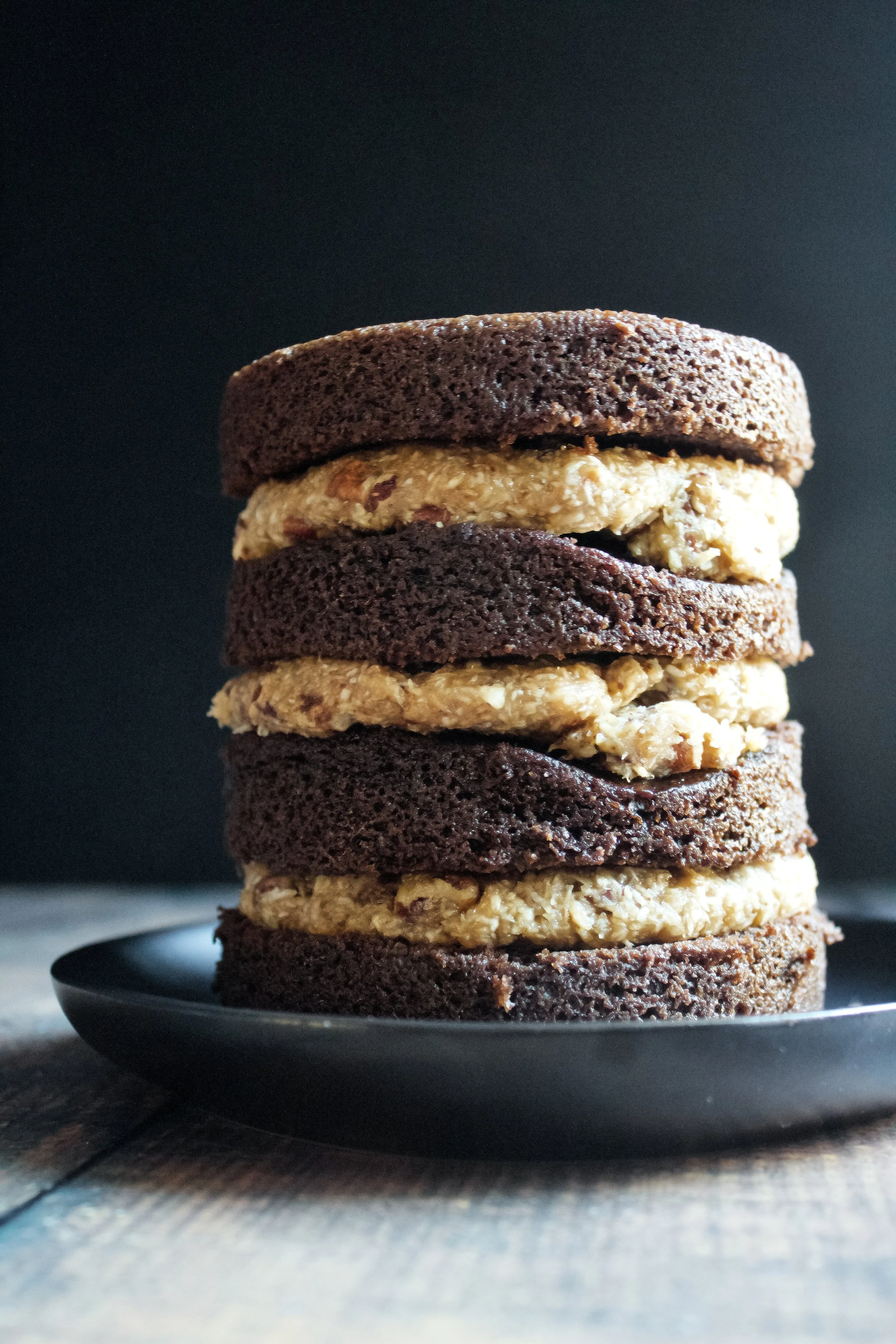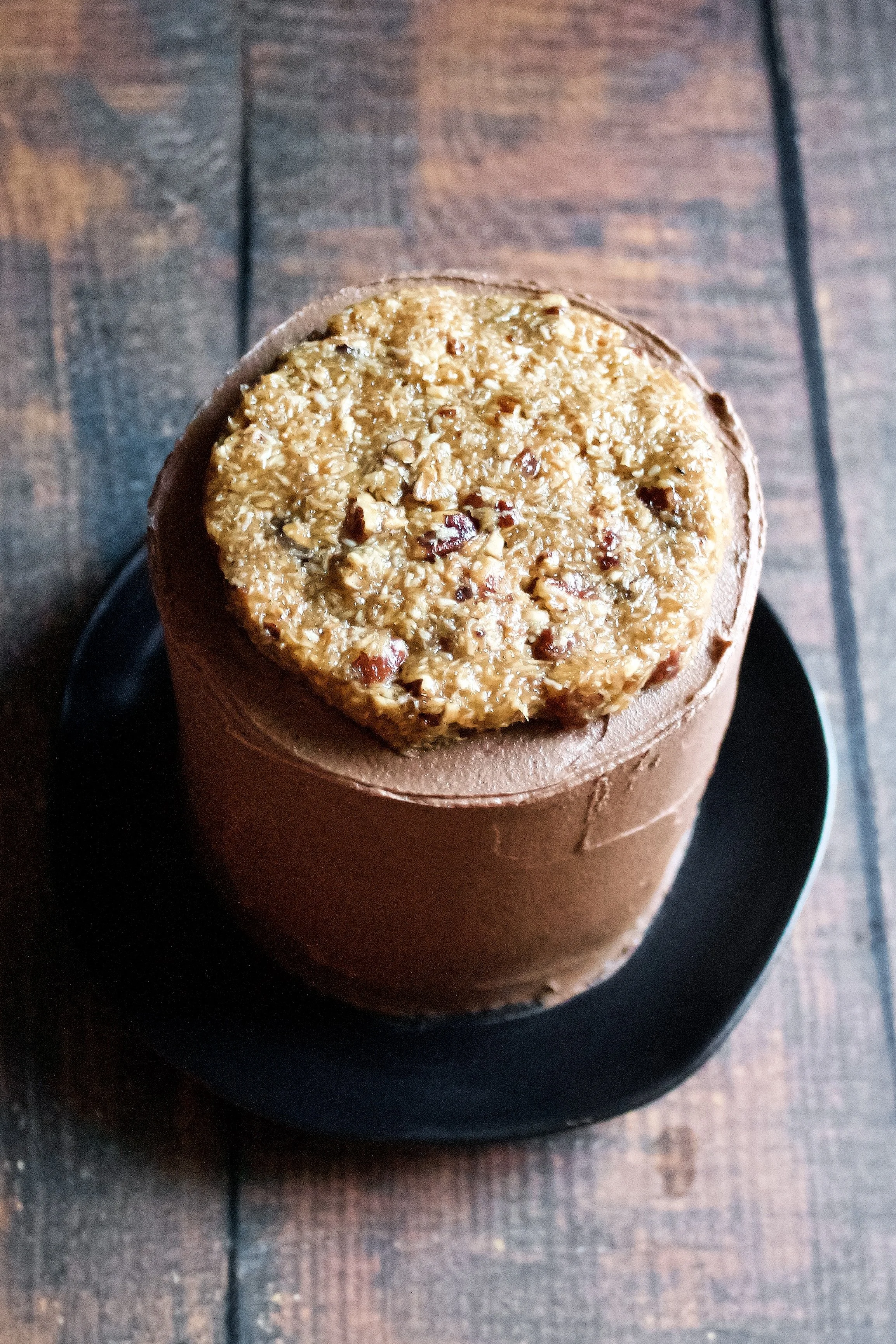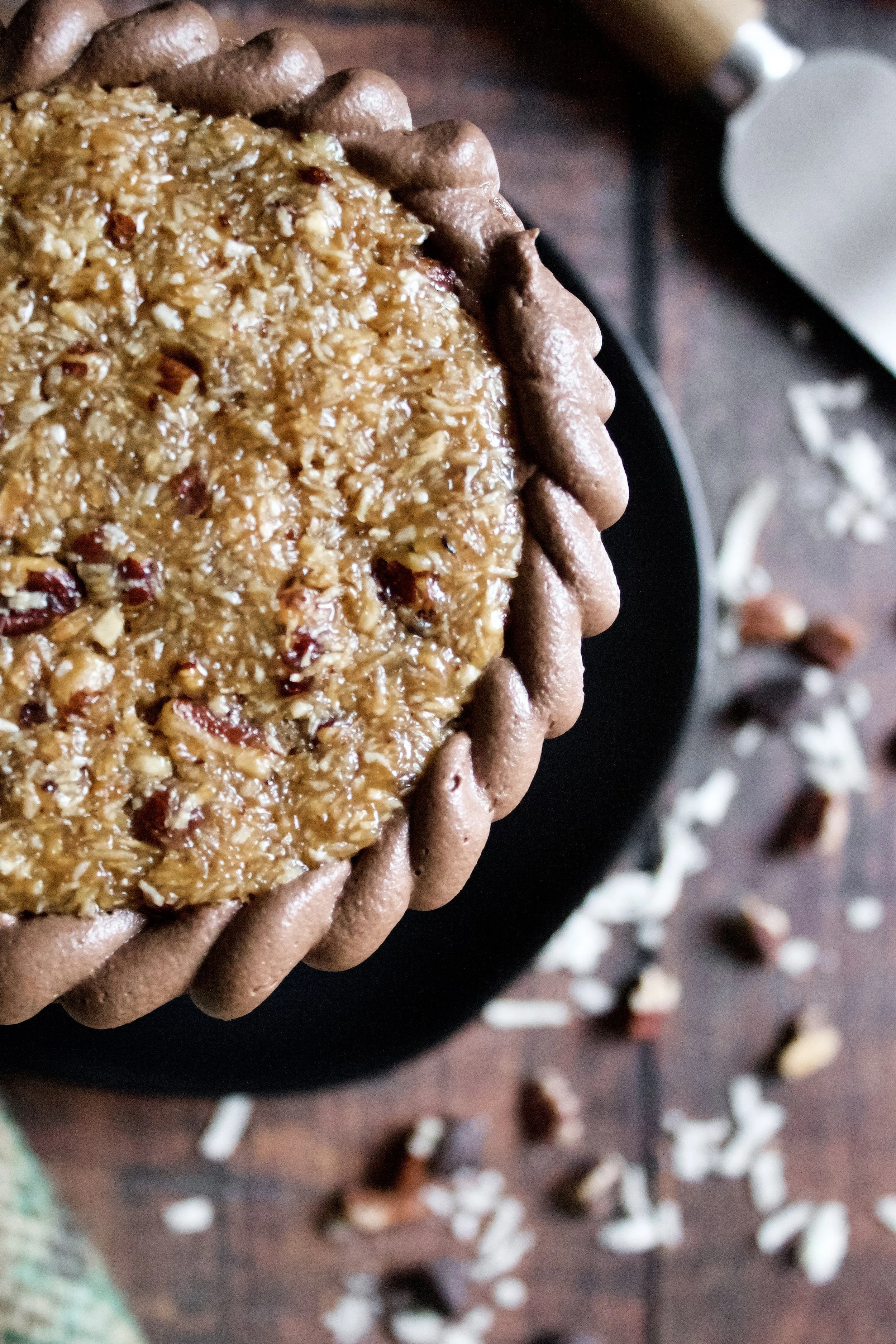German Chocolate Cake
The fluffiest, most delicious chocolate cake with a gooey, caramel-y coconut pecan filling and a smooth, rich chocolate buttercream. This take on the classic German chocolate cake is so flavorful and perfect for any Oktoberfest celebration!
This post may contain affiliate links from which, at no additional cost to you, I may earn a small commission to keep this site running. Only products I myself would or do use are recommended.
Happy Oktoberfest! I know it’s still September, but the Germans start this awesome celebration now. Good food and drinks, parties, and lederhosen as soon as possible? I like their style.
Another thing that does make sense that I’m still okay with is German chocolate cake. It’s not German. It was created in America by an English baker. So, not exactly “German”, but I still make it for our Oktoberfest parties. Because why not??
This cake has a special place in my heart, because it was the first time I made my signature chocolate cake. I’d tried several recipes out there over the years, tweaking and experimenting until I eventually narrowed in on something that was all my own and which had everything I wanted in a chocolate cake. One particular Oktoberfest, I made a cake that was richly chocolate without being bitter, moist without being dense, and fluffy without falling apart or drying out quickly.
It was magical.
So even though I don’t often pair that chocolate cake with the classic German chocolate filling, this cake will always be special to me. Plus, who doesn’t love a gooey, caramel-y, coconut-y filling paired with rich chocolate buttercream?
Why this recipe works
First, that fluffy, delicious cake! Using blond coffee helps bring out the chocolate flavor without making it too bitter or overly rich. It’s also suuuupper fluffy yet moist, thanks to using baking powder and baking soda for rise and oil for moisture.
The frosting is also one of my favorites. It’s so, so simple. Just American buttercream with cocoa powder added. Sifting the cocoa helps get the frosting very smooth. Plus, it adds stability to the frosting without needing to overload it with powdered sugar. Which pairs perfectly with the filling’s texture, which isn’t quite as sturdy.
The filling is just my favorite. It’s basically a caramel sauce with egg yolks, which gives it structure. I like to toast my coconut and pecans, for added depth of flavor, but this is optional. Together you get the sweet caramel and roasted nut/coconut flavors pairing perfectly, adding a contrast in taste and texture to this cake.
Key ingredients
Flour. Be sure to spoon then level your flour to ensure you don’t pack it in.
Cocoa powder. Unsweetened is best. You’ll need it for the cake and frosting.
Sugar. If your sugar has clumped up, you can sift it.
Baking soda/powder. Be sure these are fresh (they tend to lose their oomph about 6 months after opening).
Salt. I prefer sea salt for its health benefits and overall taste.
Buttermilk. I always make my own by adding 1 tablespoon white vinegar to my (slightly less than 1 cup) room temperature milk. Only do this 5-10 minutes before baking—ideally when the milk and eggs are room temperature and you’re now ready to get started.
Eggs. Use fresh, room temperature eggs.
Oil. I prefer avocado or grape seed oil, as they’re “health” fats with no taste (avoid extra virgin avocado oil, as it’s sometimes stronger in taste). Canola or vegetable oil work, too.
Vanilla. Use pure vanilla extract, not imitation.
Hot coffee. I prefer blonde roast for this cake, but you can use whatever you’d like. You won’t taste the coffee in the cake unless you make it VERY strong, about the level of a straight shot of espresso. Hot water does work but doesn’t make as fluffy a cake (in my experience) and the chocolate flavor is milder.
Heavy cream. Used in the filling and frosting—don’t sub milk, as they will be too thin.
Brown sugar. You can use light or dark. This will go into the filling, to create the caramel sauce.
Butter. For the filling, you’ll use salted butter, or add a pinch of sea salt with unsalted butter. The frosting calls for unsalted butter, but you could sub salted and omit the salt entirely. It just depends on what you have. Try to use European style butter, as it has less water and will make better fillings and frosting.
Evaporated milk. This goes into the filling. It’s thicker than plain milk, so be sure to use evaporated.
Shredded or flaked coconut. Use the sweetened kind, for the best flavor. I toasted mine, but you can leave it raw. Also, I prefer the texture of flaked coconut, but shredded works, too.
Pecans. These are optional, but pretty classic. You can use toasted or plain, but be sure to use chopped or chop them yourself.
Powdered sugar. Also called icing or confectioner’s sugar. This is only used in the frosting. Be sure to sift if it has clumped up.
How to make German chocolate cake
Make the cake
1. Sift and whisk dry ingredients. Don’t skip the sifting here!
2. Whisk oil, eggs, buttermilk, and vanilla. Whisk until very well blended.
3. Slowly pour in hot coffee while whisking quickly. It’s helpful to have a bowl that stays put as you do this so it doesn’t spin around while both of your hands are busy.
4. Slowly stir into dry ingredients. Do this on low in a stand mixer. Stop and scrape the bowl after it’s all combined.
5. Beat on medium for exactly 2 minutes. Set a timer—you really do want to beat it for that exact amount of time!
6. Bake. Bake until a toothpick comes out with some moist crumbs—not fully clean (that can mean it’s over baked). Let cool in the pans for 5-10 minutes then remove to a cooling rack until fully cooled.
Make the filling and frosting
7. Make the filling. Combine everything but the coconut, pecans, and vanilla in a saucepan and boil over medium heat for 5-10 minutes, until thick (like a thin caramel sauce). Stir in coconut, pecans, and vanilla. Let cool before using.
8. Make the chocolate buttercream. Beat butter, adding sugar in increments until smooth. Add sifted cocoa powder to taste. Add vanilla, salt, and heavy cream, until smooth. The original recipe has more details to make this the smoothest frosting ever.
Assemble the cake
9. Spread filling on each cake layer. Cut off any domed tops. You can also cut each cake layer in half, if desired. Just divide the filling into however many layers of cake you have.
10. Frost sides and top with chocolate buttercream. This acts as the glue to hold it all together (plus, it tastes really good!). Refrigerate to set the frosting. You can also pipe a decorative ring on top, if desired.
11. Spread filling on top of the cake. This is pretty standard on German chocolate cakes, but is optional.
Enjoy!
Tips and FAQ’s for this recipe
Can I split up my work?
Yes! There are three pieces to this cake—the cake, the filling, and the frosting. Plus, you have to put it all together. The cake layers can be made ahead. I usually make mine the night before and leave them on the counter (but only if I’ll be decorating in the morning). Just let them cool completely then wrap well with plastic. You can also freeze them, which is the most common method if making further in advance. Wrap well and place somewhere flat so the cake doesn’t freeze at an angle.
The filling and frosting can both be made ahead and kept refrigerated, in a well-sealed container. The frosting will last 1-2 weeks in the fridge (or 2 months in the freezer) and the filling will last 2-3 days. Both should be brought to room temperature before using. Be sure to give the frosting a good stir or quick whip with a hand mixer to make it smooth for spreading.
Can I make this ahead of time?
Yes! You can make the whole cake ahead of time. Be sure to frost it fully, to seal the cake layers. You can either keep it on the counter overnight OR freeze it. I don’t recommend refrigeration longer than overnight, as it is more likely to dry out the cake—even though it’s fully frosted. If you will be freezing it longer than a few hours, let it harden then double wrap with plastic. Let defrost on the counter for a 3-4 hours, leaving the plastic on for the first hour to attract the condensation away from the frosting.
Will this cake travel well or stand up to heat or humidity?
Probably. The issue with traveling with a cake is that the car ride is unpredictable. If your filling is on the looser side (which is usually preferred because it’s gooey and delicious), your cake is liable to slide around. You could either freeze it for a few hours before traveling, which will solidify the frosting and help the cake be sturdy. Or, you can assemble the cake at your location. This is time consuming but also the best way to ensure the cake doesn’t fall in transport.
As for weather, your two options are to freeze the cake for at least an hour (or overnight) and keep it in the shade if you will be serving it outside. You could also keep it in an ice chest (carefully placed to prevent smudging your lovely frosting) until serving. Or, keep it indoors until the last possible second. I’ve done this—I drove home right when my daughter’s third birthday party started to get her unicorn cake out of the fridge. We kept it in the shade (it was mid-80’s and low humidity) for nearly three hours, and it was just starting to get soft when we served it.
My tools
Here are my must-have tools I use for making this cake. Affiliate links provided.
Mesh sieve (because sifting is KEY for a fluffy cake)
All-rubber spatula (this makes scraping the bowl easier as the batter and frosting doesn’t get all over a wooden handle!)
Silicone liners for 8” cake (or for 6” cakes)
8” aluminum cake pans or 6” aluminum cake pans (I’ve found nonstick doesn’t bake as evenly)
Offset spatula (for frosting the cake)
German Chocolate Cake
- prep time: 45-50 minutes
- bake time: 25-30
- total time: 1 hour, 20 minutes (plus cooling time)
servings: 12-16
Ingredients:
for the cake
- 1 ¾ cups (351g) granulated sugar
- 1 ⅔ cups (226g) flour, sifted
- ¾ cup (75g) unsweetened cocoa powder, sifted
- 2 teaspoons (8g) baking powder
- 1 teaspoon (5g) baking soda
- ½ teaspoon (3g) sea salt
- 2 eggs, room temperature
- 1 cup (236g) buttermilk, room temperature*
- ½ cup (108g) avocado oil (can sub vegetable or canola oil)
- 1 tablespoon (13g) pure vanilla extract
- 1 cup (240g) hot, light roast coffee (or hot water)
for the filling
- ¾ cup (150g) brown sugar
- ¼ cup (50g) granulated sugar
- ½ cup (113g) salted butter**
- ¾ cup (189g) evaporated milk
- 3 egg yolks
- 1 tablespoon (13g) pure vanilla extract
- 1 ½ cups (150g) flaked coconut (can sub shredded)
- 1 cup (125g) chopped pecans
for the chocolate buttercream (double if you want a thicker frosting)
- ¾ cup (170g) unsalted European style butter, softened*
- 2-3 cups (260-390g) powdered sugar
- 2-3 tablespoons (14-21g) unsweetened cocoa powder, sifted
- ½ tablespoon (6g) pure vanilla extract
- ⅛ teaspoon (2g) sea salt (or ¼ teaspoon table salt)
- 1-2 tablespoons (15-30g) heavy whipping cream (optional--omit if your cake will be outside)
Instructions:
make the chocolate cake layers
- Preheat your oven to 325F/165C. Lightly grease and flour two or three 8" or 9” or three to four 6” cake pans (or use baking spray) and line the bottom with parchment paper or silicone baking mats. This is also a great time to set your coffee to percolate (unless using hot water or espresso and hot water, which is what I do).
- Whisk together the sugar, flour, cocoa powder, baking powder, baking soda, and salt in the bowl of your stand mixer or a large mixing bowl, sifting everything but the sugar (unless yours is fine enough to sift--go for it!). Set aside.
- In a separate medium mixing bowl, whisk the eggs, buttermilk, oil, and vanilla together until well-blended and fully emulsified, about 1 minute.
- Very, very slowly stream the hot coffee or water into the wet ingredients, whisking vigorously and constantly as you pour to avoid scrambling the eggs. Feel free to do this in segments if it’s easier. If you do scramble some of the eggs, you can run the mixture through your fine mesh sieve to remove the cooked egg bits.
- Using the paddle attachment, turn your stand mixer to low (or use a hand mixer) and slowly pour the wet ingredients into the dry. This should take about 30 seconds or so. The batter will clump up then thin out. Once you’ve poured all the wet ingredients, immediately turn off the mixer. Scrape down the bottom and sides. Beat on medium for exactly 2 minutes (set a timer).
- Evenly divide batter between prepared pans. Bake for 25-30 minutes, until a toothpick inserted in the middle of each cake comes out with just a few moist crumbs (ideally not fully clean, as this could mean they’re over baked). Check early and rotate halfway if not using convection.
- Let cool 5-10 minutes in the pans then remove to a cooling rack to cool completely.
make the German chocolate filling
- While you wait for the custard to cool, make the German chocolate cake filling. If desired, you can toast the coconut and pecans. Place in a single layer on a rimmed baking sheet and bake at 350F/175C for 5-10 minutes, stirring halfway. If omitting the pecans, increase coconut to 2 cups.
- Combine the brown sugar, sugar, butter, evaporated milk, and egg yolks in a medium to large saucepan. Cook over medium heat until boiling, stirring constantly. Let boil 5-10 minutes, until the sauce thickens an can coat the back of a spoon.
- Once thickened, remove from heat and stir in vanilla. Once fully combined, stir in coconut and pecans. Set aside to cool (or place in a sealed container and refrigerate if not using right away–let come to room temperature while you churn the ice cream).
make the chocolate buttercream
- In the bowl of your stand mixer, beat butter on high until smooth, about 30 seconds. Add in powdered sugar, one cup at a time, beating on low then increasing speed to high for 1 minute, until smooth. Scrape the bowl as needed. Taste as you go and only add as much powdered sugar as needed. You can add more after the cocoa powder if it’s necessary.
- Add sifted cocoa powder, starting with just 4 tablespoons (or ¼ cup). Beat until smooth then taste, adding more cocoa if it’s not chocolatey enough for you. Add in the vanilla extract and salt and beat until smooth.
- If it’s too thick or grainy, add in heavy whipping cream, one tablespoon at a time, until spreadable. Don’t worry if it’s a little grainy--the next step will help with that. Don’t add too much cream, as it’s impossible to recover from making it too loose.
- Once the flavor is well-balanced and to your liking, scrape the bowl then beat on high for 3-5 minutes, stopping once to scrape down the bowl. This will smooth it out quite a bit. Stir vigorously by hand for a minute to release the large air bubbles. Note: if, after beating for 5 minutes and adding some heavy whipping cream, it’s still too grainy, you can refrigerate it for a few hours or overnight. This helps smooth out almost all frostings. Just remember to let it come to room temperature on the counter then stir well before using.
assemble
- Place one layer of cooled chocolate cake on her serving plate. Cut any domed tops off of the cake and discard (or save for taste testing). If you only baked two layers of cake, you can cut each one in half, depending on if you want to get in a little extra filling. I love baking three layers of cake so I don’t have to cut any of it but still get a little more filling. You’ll want to divide the coconut filling into as many layers as you’re working with (2, 3, or 4). So, for a two layer cake, you’ll spread half of the filling onto the bottom layer, ⅓ for a three layer cake, etc. Continue filling and stacking cake until you place the top layer on–do not put filling on the top layer quite yet.
- Once all layers are stacked, frost the outside in a thin crumb coat. Refrigerate 10-20 minutes to set the frosting. Frost the sides as fully as you’d like, and create any decorating piping along the top, as desired. I used an 809 round top to pipe a rope of frosting.
- Spread the remaining coconut filling on the top of the cake. Refrigerate 20 minutes to set the frosting. Keep the cake well-sealed at room temperature until serving.
Enjoy!
Store leftovers in an airtight container. Cake should last 3-5 days at room temperature.
*You can make the buttermilk by adding 1 tablespoon of white vinegar to a 1 cup measuring cup then filling it to the 1 cup line with room temperature whole milk. Stir and let sit 5 minutes while you prep the rest of the cake.
**Use European butter, if possible. It has less water and will make a better filling and frosting. If you only have unsalted butter, add a couple pinches of salt.

